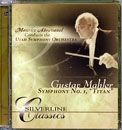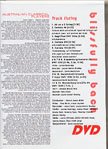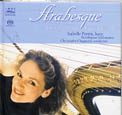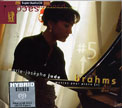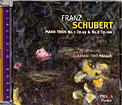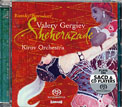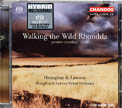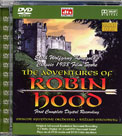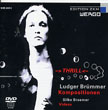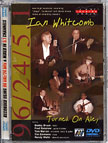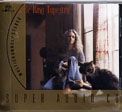|
You are reading the older HTML site Positive Feedback ISSUE 13may/june 2004
Hi-Res reviews featuring our friends from Audiophile Audition, Part
1 May 2004 - Classical, Soundtracks, Pop, and more!
MULTICHANNEL DISC OF THE MONTH
MAHLER: Symphony No. 1 "Titan" - Utah Symphony Orchestra/Maurice Abravanel - Vanguard/Silverline Classics multichannel DVD-A 288238-9 This is the first of a series of some of the great quad-era masters recorded by the Solomon brothers at Vanguard in the early 1970s and an auspicious start to be sure. Rather than retaining the four-channel layout from the original analog master tapes (as in the Pentatone RQR series), a remix to 5.1 surround has been done—first converting the analog originals to 192K digital, and both the multichannel and stereo options are then reduced to 96K/24 bit. The original recording was made in the voluminous acoustics of the Mormon Tabernacle in June of l974. Abravanel's Mahler series still holds its own against some very tough competition; it's quite surprising what he accomplished in Salt Lake City during his long tenure there. It may be apparent we're not listening to the Berlin Philharmonic here, but in its glorious multichannel presence this is an extremely dramatic, involving and exciting performance for which no excuses need be made—even for the sonic quality. While I've been bowled over by the Tilson Thomas SF Symphony Mahler series in general, I found Abravanel's First somehow more enjoyable than Tilson Thomas's recent SACD of it. Silverline has provided many extras on this DVD-A: There is a bio of Mahler, a list of the equipment used in the restoration process, including an Ampex ATR-104 open reel deck with ARIA playback electronics, and three videos. In the one on Restoring and Transferring a Legacy, a representative of 5.1 Production Services offers the narration for a slide show on the technical process. He reveals that although the original tapes were in excellent shape (since they were from the period before new oxide formulations were tried which quickly separated from the base material) both the actual masters and dubs of them were all labeled Masters, thus confusing the search for the originals. Another interesting tech point is that with the heightened resolution and lowered noise level natural sounds which occurred during the original recordings become much more noticeable—page-turning, chair-sqeaking, etc. Perhaps that's an unappreciated factor in contributing to the enhanced "you are there" feeling of hi-res surround reproduction in general! There is a short video interview with a percussionist from the symphony about working with Abravanel. He says that due to the conductor having studied with Bruno Walter who conducted Mahler while the composer was still alive, he felt they were "getting Mahler very close-hand." Finally, the former Associate Conductor and Pianist for the Symphony, Ardean Watts, reads the eulogy he delivered at Abravanel's funeral in 1992 while we see photos of various events in his career and life. Very moving and informative for those of us who didn't know much about the Utah conductor. I for one am looking forward expectantly to the future releases in this series from Vanguard/Artimis/Silverline Classics! John Sunier
VIVALDI: L'Estro Armonico Op. 3, Vol. II: Concertos Nos. 7 thru 12 - Soloists/Accademia Bizantina/Ottavio Dantone - Arts Music multichannel DVD-A 45003-6DVD We reviewed this organization's disc of the complete Op. 8 of Vivaldi (the one with The Four Seasons) in our November 2003 issue, but something new has been added in this one: The disc is now also a DVD-A whereas before it was only 96K PCM stereo—in other words, a DAAD such as Classic Records issues. You can still play back a linear PCM stereo track at 96/24 from the disc if your DVD player outputs that, but there is also a 5.1 channel 96/24 surround sound option—evidently (as with the Naxos series) not using MLP lossless data reduction. Plus Dolby Digital 5.1. Musically, these are the other half dozen concertos of Op. 3. (We seem to have missed out on Volume I.) They're just as lovely, and the various violin and cello soloists play them with a pizazz that counters the joke about Vivaldi composing with a couple of stencils that he just moved around the score. The note booklet is very complete and useful in its analysis of the music. Let me quote myself from the earlier volume's review to close this out: "perhaps you will find the Accademia Bizantina a just-right combination of informed musicology, interpretive energy and pleasant timbre." John Sunier
"Blissfully Bach" - Air on G String, Magnificat BWV 243a, Arias from Cantatas 208/182/46, Brandenburg Concerto No. 5, Harpsichord Concerto in F Major, Brandenburg Concerto No. 4 - Australian Classical Players/Patrick James Miller "Cutting Edge #1" - HAYDN: Piano Trio in D Major, CHARLES IVES: Piano Trio, BRAHMS: Piano Trio in A Major Op. posth., [Encore:] Cinema Paradiso theme - Macquarie Trio (Kathryn Selby, piano/Nicholas Milton, violin/Michael Goldschlager, cello) - Kostas Metaxas Ultra-Resolution Recordings (2 DVD-Rs at 48K/16 bit) These are the latest digital transfers to DVD from the Australian audio maven who made his original analog recordings with a Stellavox open reel deck and purist mics. We reviewed the first ones last issue. The Bach program is good listening but has been done better. The three piano trios are a complete delight (especially the Brahms)—glorious playing with super-natural sonics that bring them right into your listening room. Mataxas found that doing EQ and processing of digital material in the PC caused it to lose the highest fidelity it had in analog form, so he only used it to transfer straight across to 48/16 without any editing, compression, filtering or EQ. The result, as on his earlier DVDs, is a clarity and presence not heard on most commercial recordings. I noticed something odd with the Bach harpsichord concerto. With my Sunfire preamp set to Source Direct—no processing to the signal at all—it sounded like a pair of harpsichords but with the right channel one louder. Switching to the Stereo setting made it sound more like a single instrument but reduced in transparency. Finally I tried Pro Logic II and that produced a single instrument center stage, with more realistic width and depth of all the musicians playing - even with the surround speakers off. Due to my decades of working with analog tape and editing it with razor blade and cutting block, my ears are seriously upset to hear the artifacts of not-quite-perfect analog tape playback. I speak of dropouts, bad splices, tape pulling briefly away from the playback heads, even subtle speed anomalies. These are present and clearly heard on the DVDs but they probably wouldn't conjure up the disasters in most listeners' brains that they do in mine! It seems that some of those glitches could have been repaired on the original analog tape before digital transfer. There are several abrupt starts and stops of the music and audience sounds instead of smooth fades—perhaps that too would have involved using digital circuitry that would have destroyed the sonic realism. Also, be warned that these are all DVD-Rs and your player must be able to play them. (Although I believe more different DVD-V players will play DVD-Rs than CD players will play CD-Rs.) Full details on ordering these unique discs will be found at www.metaxas.com. John Sunier
l though most hi-res releases now are multichannel, there are still some fine new offerings coming out in stereo only. The Hi-Res label has issued several acclaimed two-channel DVD-As, and many of the earlier classical and jazz releases from Sony Music have been stereo only. Some of the highest-end SACD players (Musical Fidelity Nu-Vista, Shanling) are two-channel only, and the DVD recorder we review in our components section this month is two-channel DVD-Audio only. The two-channel diehards still benefit from a stereo mix designed especially for them and found on all multichannel SACDs, while DVD-A users must usually be satisfied with an automatic mixdown of the 5.1 tracks. Let's start this part with three stereo-only SACDs.
Arabesque, A Journey Into Harp Artistry - HASSELMANS: La Source, MOZART: Aria and Rondo Pastoral, CHOPIN: Prelude Op. 28 No. 15, Chinese trad.: Flowing Stream, DUSSEK: Sonata in C Minor, SALZEDO: Chanson dans la Nuit, THOMAS: Minstel's Adieu to his Native Land, PARISH-ALVARS: Serenade, RESPIGHI: Siciliana, DEBUSSY: Arabesque, Danses sacree et profane - Isabelle Perrin, harp; Northwest Sinfonietta/Christophe Chagnard (on Danses only) - First Impression Music Stereo SACD M 045 The conductor of this disc, who also functioned as producer, reports that he picked harpist Perrin out of the 800 harpists who converged on Tacoma, Washington in l996 for the Sixth World Harp Congress. The French harpist has assembled a varied program of 11 tracks, using some concert harp standards such as the Debussy works and the Dussek Sonata, some transcriptions of works for piano, lute and other instruments and one Chinese folk melody which was played originally on a native folk instrument. The concert harp is notoriously difficult to record properly, and this SACD shows it can be done with flying colors using DSD mastering. All except the final Debussy track are harp solos. the attractive packaging has notes by Ms. Perrin on each of her selections. John Sunier
BRAHMS: Sonata No. 1 in C Major; Variations Op. 21; Chaconne for left hand only after Bach - Marie-Josephe Jude, piano - Lyrinx stereo SACD LYR 2213 Brahms was only 19 when he composed this sonata but it is unmistakably Brahms through and through, although in its frequent forcefulness it has elements of the powerful side of Beethoven. A lovely melody permeates the Andante movement as though sung by a vocalist, and it is played in the left hand while the right ornaments it as a choir might a soloist. The Variations are a quieter sort of work without blatant virtuosity; they show a debt to both Bach and Beethoven. While Brahms added to the small library of works for left hand alone with his infrequently-heard arrangement of Bach's Chaconne, he didn't write it for a one-armed pianist as is the case with most of the other such pieces. Instead, he was convinced that the only way to reproduce the essential truth of the original for unaccompanied violin was to compose it for the left hand only, producing on the piano the arpeggiated effects which are necessary on the solo violin. Sonics are clean and detailed and the piano seems normal-sized across the soundstage. John Sunier
SCHUBERT: Piano Trios Nos. 1 & 2 - Guarneri Trio Prague - Praga Digitals stereo PRD/DSD 250 201 (Distr. by Harmonia mundi) I had to smile when I saw the modification to the little box symbol most SACDs now have - usually with Stereo in the top and Multi-Ch in the bottom. On this disc it now reads Bi-channel on the top and Stereo on the bottom. with the Bi in bold. Of course it's just standard stereo. I tend to find piano trios more interesting than string quartets, and No. 1 in B Flat is one of my favorites for its very sunny and optimistic tenor. This was in spite of the composer going thru some very difficult and disturbing times in his life and realizing he was seriously ill on top of it. There is a bit of gloom in the Andante movement but it is soon dispelled. The last movement is an homage to Vienna, in rondo form. The second trio, composed the same year, is less sunny and has been described as "Schubert walking among his memories." I find these performances fully the equal of any others I have in my collection, including one on audiophile vinyl, and clearly more transparent and natural sonically. John Sunier
RIMSKY-KORSAKOV: Sheherazade, Op. 35/BORODIN: In the Steppes of Central Asia/BALAKIREV: Islamey (orch. Lyapunov) - Sergei Levitin, violin/Valery Gergiev conducts Kirov Orchestra - Philips multichannel SACD 289 470 618-2 62:31 (Distrib. Universal) We reviewed the 44.1 CD version of this release in our Classical section back in February of last year and I only have a couple things to add for the hi-res version, so we'll follow this with the original CD review. Though, as with many SACD releases from major labels it originates from multichannel PCM masters (in this case at 48K/24bit), the step up to surround sound raises the sonic sensuality many levels. Those wonderful inner voicings mentioned by Gary are now transparent to a degree the 44.1 CD couldn't offer. John Sunier I have been living with Rimsky-Korsakov's Sheherazade for half a century, when I first owned the Dorati version with the London Philharmonic on 78 rpms. Since then, I have heard every conceivable interpretation, so that the ones that really stand out continue to be the Beecham, Reiner, Fricsay, Celibidache, Golovanov (in his own way) and now, this one. He has fashioned the Kirov Orchestra of St. Petersburg into a sensitive, responsive instrument that has ballet and exotic rhythms at the center of its being. I recall an anecdote of Beecham's, speaking of a meeting with Sibelius at the composer's home: when Beecham entered the living room, the record player was on so loudly that Beecham had to back out into the patio. "I like to hear everything!" shouted Sibelius, in justification of the volume. So too will you raise the volume levels on this splendid disc: it has colors to burn, with sweeping, broad tempos and wonderful inner voicings between clarinet, violin solo, violas, harp, flute and cellos. It has languor, wit, heraldry, pomp, and rousing trumpet sections. If your imagination is infiltrated by magic lamps, flying carpets, Sabu, Rex Ingram and Conrad Veidt, you will want this CD. The Borodin and Balakirev entries only extend the vivacious and exotic colors that the Mighty Five could conjure up, in no less pageantry but on a smaller scale. The playing, by the way, is all virtuoso caliber, making Gergiev the closest thing to Mengelberg we have on the current international music scene. Gary Lemco
Please Welcome...Matt Haimovitz, cello - BACH: Suite no. 2 for Solo Cello; MACHOVER: Begin Again Again; CHOPIN: Polonaise brillante Op. 3; PAGANINI: Variations on a Theme by Rossini; TOBA TWINING: 9:11 Blues; JIMI HENDRIX/HAIMOVITZ: Anthem; HILDEGARD VON BINGEN: Slice for St. Ursula - Oxingale/Artemis Classics stereo SACD ATM1229 Another of the new breed of crossover crashers, young Haimovitz not only puts together extraordinary programs of music for solo cello and with one or two other musicians, but doesn't limit himself to the concert or recital stage. He has performed in jazz clubs, bars—anywhere he can challenge audiences with a brash new approach to classical music. Dig his version of the infamous Jimi Hendrix electronic music version of The Star Spangled Banner—unbelievable! His playing of the Chopin and Paganini selections show he can shine in more standard cello/piano repertory. His accompanist here is Itamar Golan. Soprano Eileen Clark joins him for the closing von Bingen selection. The Bach suite understandably lacks the depth of someone like Rostropovich or Casals, but think of the audiences he is reaching with this music for the first time. The sACD is a compilation from the several previous CDs Haimovitz recorded for Oxingale Records. John Sunier
"Walking the Wild Rhondda" - IAN LAWSON: 4 Celtic Fanfares; Ghost Train; BEN HENEGHAN: House at the North Pole; Walking the Wild Rhondda - Heneghan & Lawson Virtual Orchestra - Chandos multichannel SACD CHSA 5010 Most readers will no doubt be familiar with the virtual electronic orchestra recordings of Tomita and Wendy Carlos. The Welsh composer team of Heneghan and Lawson differ in that they don't use aural gimmicks, they compose their own music from scratch rather than do electronic versions of familiar pieces as does Tomita, and they are more strongly in a tonal bag than is Wendy Carlos in her original compositions. Also, the technology of just what can be done with music and computers has advanced even further; while this music cannot claim to be indistinguishable from a real acoustic orchestra at times its pretty darn convincing! Yet another positive factor here is that these complex digital files have been transferred directly from the computer to both a stereo SACD mix and a multichannel SACD mix, without going thru either analog electronic or transducer/acoustic steps. Therefore, the preservation of the original data is more perfect, just as the picture quality of the Finding Nemo DVDs were because the original digital animation never went thru a film step during the transfer. The music is extremely evocative and involving. Both composers have worked for years in the film and TV music field, as well as in the visual side of production. Lawson himself created the Celtic themes he used in his fanfares. His description of Ghost Train made me think of the mystical train in the anime Spirited Away. While most of the music is orchestrated in the best genuine-orchestral manner, the electronics do offer the possibility of effects difficult to get in real life. Such as the ghostly sounds of sirens in the distance at the end of Wild Rhondda (a former coal-mining area of Wales). And even to moving a few instruments around the listening room at the end of House at the Noth Pole, which had among other stimuli research into the "spirit journeys" of Siberian shamans who used hallucinogenic Amanita mushrooms. John Sunier
Three hi-res soundtracks—one complete with images...
ERICH WOLFGANG KORNGOLD: The Adventures of Robin Hood - Moscow Symphony Orchestra/William Stromberg (Score restorations by John Morgan) - Naxos multichannel DVD-A 5.220501 The latest in the series of collaborations on film music recordings between film score expert Morgan and conductor Stromberg had a delayed release date but here it is and the wait was worth it. it is the first complete digital recording of the entire score Korngold composed for the 1938 Errol Flynn Technicolor film. There were several previous recordings of a suite of about a quarter hour from the score, plus a 1983 Varese Saraband LP with the Utah Symphony. Unfortunately the last was designed for the 40 minutes or so of LP length and was a half hour short of the complete score heard on this new recording in hi-res surround. It is considered even today as one of the finest examples of marrying classical music to the moving screen image. Korngold, who set the standard for Hollywood film scores for many decades, used operatic techniques in his score. Each character had their own fitting theme and certain set pieces had their own theme - such as the Chase of Robin Hood, and the Archery Tournament. As a whole the score contains 15 main themes and at least six secondary motifs. The score was entirely instrumental without vocals because Warners was planning to shoot an operetta version of Robin Hood later with Nelson Eddy and Jeanette McDonald. But Korngold's catchy melodies did the singing on their own. The versatile Moscow Symphony has been the busiest orchestra in Russia lately, recording both standard orchestral works and many film scores for Naxos and others. The disc has 26 separate tracks and for once the on-screen display of the titles is most helpful in keeping track of where you are in the score. There is also a running description of the film's action track by track in the note booklet. This is a 48K sampling recording and richly draws in the listener with its enveloping surround sound. Surely this is one of the most important film music recordings of the year.
ENNIO MORRICONE: The Mission - London Philharmonic/Morricone, London Voices Choir; Indian instruments - Incantation - Virgin stereo SACD 72438 11267 2 1 The 1986 motion picture starred Jeremy Irons and Robert DeNiro as two men bringing civilization to natives deep in the Amazon jungle. They find themselves on opposed sides of a fight for the independence of the natives. This has to be one of the high points of the long list of movie scores Morricone has created—probably more than any other composer living today. The combination of the native instruments, the liturgical choirs and the expansive orchestral themes results in an unforgettable musical experience even you haven't seen the magnificent film. There are 20 cues, some as short as 46 seconds and none much over four minutes. Sonics are exceptional, and the stereo translates well to pseudo-surround via Pro Logic II. Film soundtracks—even on standard CDs—have certainly come a long way from the many LPs which were sourced directly from the soundtracks on film. Making new recordings of restored scores with a full symphony was the first step; offering them in hi-res such as this one is the next. John Sunier
LUDGER BRÜMMER: Phrenos; Lizard Point; de la nuit; Thrill; Inferno der Stille - electro-acoustic compositions. Plus videos by Silke Braemer to Lizard Point & Thrill - Wergo DVD-A, DVD-V & DVD-ROM WER 2059 5 (100 minutes) It is not easy to report on this disc from the German avantgarde label Wergo and it was not easy to decide whether to put it in the DVD Video section or the Hi-Res section. The foreword in the note booklet points out that there has been a tradition of multichannel music reproduction for almost half a century now—most music lovers probably weren't even aware of it. It was the specific composition of electronic music for multiple channels and for speakers distributed throughout the performance space. Sounds can take on newer and stronger character by their movement around the audience and their layering one on top of another. Although I tend to prefer early musique concrete works and "tape recorder music" to most of the electronic music being composed today, I enjoyed several fascinating multichannel outdoor nighttime concerts at Stanford University put on by their CCRMA organization. (Leon Theremin even was guest of honor at one.) Unfortunately, it was not possible to properly present these multichannel works on the standard two-channel media which were available. When they were mixed down to stereo they lost much of their meaning. Now with SACD and DVD-A the full possibilities of these electro-acoustic works can be heard in the home, and this is one of the first offerings. The disc takes advantage of just about every conceivable audio format. The strictly audio section offers DVD-A multichannel at 48K without MLP data reduction. Most of the works are 4.0 channel but Inferno is 5.0. There is also Dolby Digital encoding available for those lacking DVD-A playback, and on the two video selections there is also DTS 4.0. On top of all this, the composition Inferno der Stille was originally created as an eight-channel work. it was mixed down to five channels for the DVD playback, but there is also a DVD-ROM partition on the disc with individual AIFF soundfiles for each of the original eight channels. These can be opened with computer recording/editing software and presented with eight discrete channels if one has the required gear at hand. After struggling thru the first audio-only work on the disc I moved to the two video-art numbers, using their DTS tracks. The mostly abstract images on the screen increased my understanding and appreciation of the often noise-based sounds zooming around the listening room. Some dancers were involved in both works, and most of the images are high contrast black and white. Sudden explosions of light and/or movement on screen are synchronized to sudden explosions of harsh sounds on the multichannel soundtrack. I have no idea of what is supposed to be going on here, and frankly I doubt if I will ever get around to giving it a second hearing. Inferno seemed to have the most going for it in the audio-only area, but at 23 minutes it overstayed its welcome as far as I was concerned. Some of the deepest bass sounds nearly blew out one of my subwoofers, so watch the volume levels if you audition this material. The dynamic range appears to be greater than any recording I have ever heard—several times it seemed total silence had ensued, but turning up the level found extremely low rumblings going on. I'll resist making a flip play on words on the composer's last name... John Sunier
Andrew MacGregor, shakuhachi/Haruko Watanabe, koto and 21-string koto (guest cellist - Tim Blake) - Autumn Fantasy - Kostas Metaxas Purist Recordings 48K PCM DVD Somehow a shakuhachi virtuoso named Andrew MacGregor seems a bit unbelievable, but you better believe it. The Australian bamboo flutist is at such a high level that he was a finalist last year in the All-Japan National Music Competition. (Well after all the shakuhachi is just a tiny digeridoo with holes in it.) There are ten selections including some rehearsal material. One is for solo shakuhachi and the others have the koto accompaniment. The couple with cello added make a wonderful trio of sounds. There is a considerable amount of room/hall noise ambiance under the music, but it doesn't distract from a very listenable and meditative program. However, I did find the rough tape editing and sudden cutting out and back in between selections to be distracting. John Sunier
Ian Whitcomb and The Bungalow Boys - Turned On Alley (Whitcomb, ukulele & vocals; Bobby Bruce, violin; Fred Sokolow, guitar; Tom Marion, guitar/banjo/mandolin; Tim Emmons, bass; Randy Woltz, vibes & percussion) - Aix Records DVD-A & DVD-V 80024 Whitcomb comes out of the British music hall/vaudeville tradition and was also a rock musician in the 60s, though he appears younger than that. He has been involved in many different projects in the area of vintage songs and you'll soon be intimately familiar with all of them if you stay with the very long bio on him which is part of the many extras on this disc. There are also four vintage videos of his performances, showing his relaxed stage presence. The Aix discs furnish two different acoustics for the live video side of the disc—"Stage" or "Audience." The video production has improved greatly from earlier Aix discs; it often has split screen effects and especially with the DTS soundtrack I find I preferred it to the DVD-A option. After all, this is not the sort of music where the utmost in hi-res is really necessary. There is also a photo gallery and a separate 96K stereo mix. While I must confess these old songs hold little musical interest for me, I found the video commentaries section of greatest interest. It seems to be designed for viewing after one has seen or heard the entire musical performance on the disc. Then Whitcomb appears in a small frame on the left side of the screen, wearing headphones, while on the right side of the screen we have the video of the particular song he's discussing—but with the volume turned way down. (I raised the volume to hear that better before his voice on the commentary came on and nearly blew me away...) He discusses the history and social setting of each song, and most of them have plenty to talk about. For example on "I'll See You in C-U-B-A" he sets the scene with Prohibition and people traveling to Cuba to drink, the entertainers and music there, etc. He also holds up the original sheet music and talks about the importance of that way of promoting new songs to the public to play on their pianos and sing. One could learn a lot about early 20th century popular music from Whitcomb. Tracks: Hello, What a Wonderful World, I Still Get a Thrill Thinking of You, I'll See You in C-U-B-A, Are You Lonesome Tonight?, Right or Wrong, Hesitation Blues, Dada! Dada!, The Pied Piper of Hamelin, Things That Remind Me of You, Meow!, Amapola, When We're Dancing. John Sunier
Carole King - Tapestry - Ode/Epic/Legacy multichannel SACD ES 86328 A recent book on the boomers generation pinpoints the start of the thing to this groundbreaking 1974 original LP by Carole King. It was No. 1 on the charts for 15 weeks and earned four Grammy Awards. The singer-songwriter seemed to come out of nowhere and blended her heartfelt lyrics with soothing pop/folk sounds. Lou Adler was the album producer. On some tracks Carole accompanies herself on the piano, on others a small group backs here, even to backup singers on some. James Taylor played guitar on some tracks. Two previously unreleased tracks are included here at the end of the material which constituted the original LP. If you have this LP still in your collection my bet is it no longer displays the quietest surfaces. and now you can have not only hi-res Carole King but 5.1 surround Carole King! All lyrics are included but the voices are nearly all highly intelligible. She'll come to take you back. Tracks: I Feel the Earth Move, So Far Away, It's Too Late, Home Again, Beautiful, Way Over Yonder, You've Got a Friend, Where You Lead, Will You Love Me Tomorrow?, Smackwater Jack, Tapestry, You Make Me Feel Like a Natural Woman, Out in the Cold, Smackwater Jack (live version) John Henry Reviews reprinted with permission from Audiophile Audition
|


